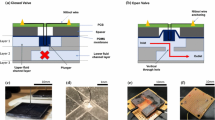Abstract
In drug delivery systems microvalves are the key components that have been developed for active control of drugs. In this research a normally closed microvalve with a glucose sensitive hydrogel actuating system is designed and simulated. Swelling of the hydrogel forces a silicone rubber membrane to deflect and causes the valve to be opened. The component of the valve that can be opened because of the hydrogel pressure is a silicon nitride cantilever beam which is sealed with a parylene layer. Simulations have been done by FEM analysis and the results show that membrane deflection is large enough to enable the valve to be opened and the fluid to flow through the microchannel. For both rectangular and trapezoidal microchannels with various hydraulic diameters, output flow rates less than 50 μl/min to several hundreds of μl/min can be achieved. Final design has been optimized for the opening point of microvalve at glucose concentration of 15 mM. Overall investigation has been done for a microvalve with specific dimensions and with 4 kPa input pressure the output flow rate of 100 μl/min has been generated which is in the desired range.
















Similar content being viewed by others
References
Baldi A, Gu Y, Loftness PE, Siegel RA, Ziaie B (2003) A hydrogel-actuated environmentally sensitive microvalve for active flow control. J Microelectromech Syst 12(5):613–621. doi:10.1109/JMEMS.2003.818070
Baldi A, Lei M, Gu Y, Siegel RA, Ziaie B (2006) A microstructured silicon membrane with entrapped hydrogels for environmentally sensitive fluid gating. Sens Actuators B 114:9–18. doi:10.1016/j.snb.2005.04.020
Chuang WH, Fetting RK, Ghodssi R (2005) An electrostatic actuator for fatigue testing of low-stress LPCVD silicon nitride thin films. Sens Actuators A 121:557–565
Eddington DT, Beebe DJ (2004) A valved responsive hydrogel microdispensing device with integrated pressure source. J Microelectromech Syst 13(4):586–593. doi:10.1109/JMEMS.2004.832190
Feng GH, Kim ES (2004) Micropump based on PZT unimorph and one-way arylene valves. J Micromech Microeng 14:429–435. doi:10.1088/0960-1317/14/4/001
Gere JM, Timoshenko SP (1997) Mechanics of materials, 3rd edition. PWS Pub Co., Boston
Giovanni M (1982) Flat and corrugated diaphragm design handbook. M. Dekker, New York
Madou MJ (2002) Fundamentals of microfabrication, 2nd edn. CRC Press, Boca Raton, FL
Morini GL (2004) Laminar liquid flow through silicon microchannels. J Fluids Eng 126:485–489. doi:10.1115/1.1760545
Nguyen NT, Wereley ST (2002) Fundamentals and applications of microfluidics. Artech house
Park JY, Oh HJ, Kim DJ, Baek JY, Lee SH (2006) A polymeric microfluidic valve employing a pH-responsive hydrogel microsphere as an actuating source. J Micromech Microeng 16:656–663. doi:10.1088/0960-1317/16/3/022
Richter A, Kuckling D, Howitz S, Gehring T, Arndt KF (2003) Electronically controllable microvalves based on smart hydrogels: magnitudes and potential applications. J Microelectromech Syst 12(5):748–753. doi:10.1109/JMEMS.2003.817898
Saliterman SS (2006) Fundamentals of BioMEMS and medical microdevices. Wiley interscience, SPIE Press, Washington
Shah RK, London AL (1978) Laminar flow forced convection in ducts. Academic Press, London
Siegel RA, Gu Y, Baldi A, Ziaie B (2004) Novel swelling/shrinking behaviors of glucose binding hydrogels and their potential use in a microfluidic insulin delivery system. Macromol Symp 207:249–256. doi:10.1002/masy.200450322
White FM (1991) Viscous fluid flow, 2nd edn. McGraw-Hill, New York
Zachary Hilt J, Peppas NA (2005) Microfabricated drug delivery devices. Int J Pharm 306:15–23. doi:10.1016/j.ijpharm.2005.09.022
Zhang Y, Kato S, Anazawa T (2008) A microchannel concentrator controlled by integral thermoresponsive valves. Sens Actuators B 129:481–486. doi:10.1016/j.snb.2007.08.015
Acknowledgment
This work is financially supported by Malaysian Ministry of Higher Education.
Author information
Authors and Affiliations
Corresponding author
Rights and permissions
About this article
Cite this article
Tehranirokh, M., Majlis, B.Y. & Bais, B. Design and simulation of a normally closed glucose sensitive hydrogel based microvalve. Microsyst Technol 15, 753–762 (2009). https://doi.org/10.1007/s00542-009-0785-6
Received:
Accepted:
Published:
Issue Date:
DOI: https://doi.org/10.1007/s00542-009-0785-6




